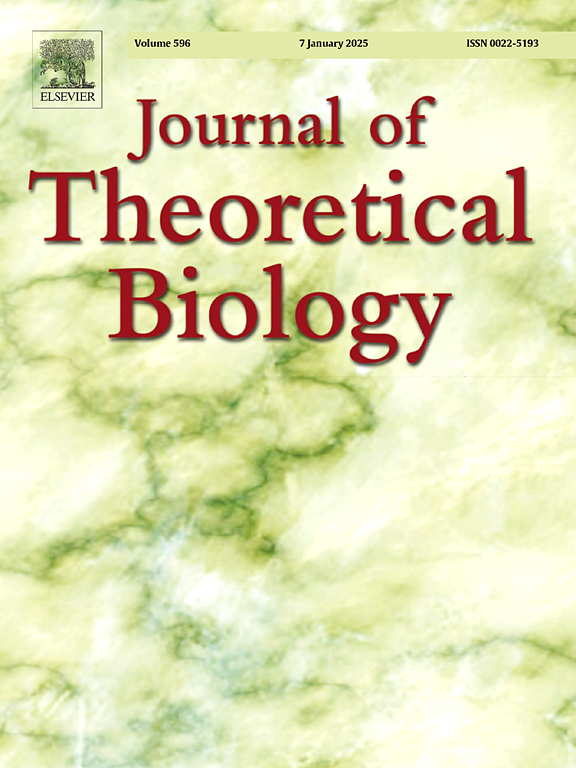Efficient coupling of within-and between-host infectious disease dynamics
IF 1.9
4区 数学
Q2 BIOLOGY
引用次数: 0
Abstract
Mathematical models of infectious disease transmission typically neglect within-host dynamics. Yet within-host dynamics – including pathogen replication, host immune responses, and interactions with microbiota – are crucial not only for determining the progression of disease at the individual level, but also for driving within-host evolution and onwards transmission, and therefore shape dynamics at the population level. Various approaches have been proposed to model both within- and between-host dynamics, but these typically require considerable simplifying assumptions to couple processes at contrasting scales (e.g., the within-host dynamics quickly reach a steady state) or are computationally intensive. Here we propose a novel, readily adaptable and broadly applicable method for modelling both within- and between-host processes which can fully couple dynamics across scales and is both realistic and computationally efficient. By individually tracking the deterministic within-host dynamics of infected individuals, and stochastically coupling these to continuous host state variables at the population-level, we take advantage of fast numerical methods at both scales while still capturing individual transient within-host dynamics and stochasticity in transmission between hosts. Our approach closely agrees with full stochastic individual-based simulations and is especially useful when the within-host dynamics do not rapidly reach a steady state or over longer timescales to track pathogen evolution. By applying our method to different pathogen growth scenarios we show how common simplifying assumptions fundamentally change epidemiological and evolutionary dynamics.
宿主内和宿主间传染病动力学的有效耦合
传染病传播的数学模型通常忽略宿主内动力学。然而,宿主内动态——包括病原体复制、宿主免疫反应和与微生物群的相互作用——不仅对确定个体水平上的疾病进展至关重要,而且对驱动宿主内进化和向前传播至关重要,因此在种群水平上形成动态。已经提出了各种方法来模拟宿主内部和宿主之间的动态,但这些通常需要相当简化的假设来在不同的尺度上耦合过程(例如,宿主内部动态迅速达到稳定状态)或计算密集。在这里,我们提出了一种新颖的,易于适应和广泛适用的方法来模拟宿主内部和宿主之间的过程,它可以完全耦合跨尺度的动力学,既现实又计算效率高。通过单独跟踪受感染个体的确定性宿主内动态,并将其随机耦合到种群水平上的连续宿主状态变量,我们在两个尺度上都利用了快速数值方法,同时仍然捕获了个体的瞬态宿主内动态和宿主之间传播的随机性。我们的方法与完全随机的基于个体的模拟非常一致,当宿主内动态不能迅速达到稳定状态或在较长的时间尺度上跟踪病原体进化时,这种方法特别有用。通过将我们的方法应用于不同的病原体生长情景,我们展示了常见的简化假设如何从根本上改变流行病学和进化动力学。
本文章由计算机程序翻译,如有差异,请以英文原文为准。
求助全文
约1分钟内获得全文
求助全文
来源期刊
CiteScore
4.20
自引率
5.00%
发文量
218
审稿时长
51 days
期刊介绍:
The Journal of Theoretical Biology is the leading forum for theoretical perspectives that give insight into biological processes. It covers a very wide range of topics and is of interest to biologists in many areas of research, including:
• Brain and Neuroscience
• Cancer Growth and Treatment
• Cell Biology
• Developmental Biology
• Ecology
• Evolution
• Immunology,
• Infectious and non-infectious Diseases,
• Mathematical, Computational, Biophysical and Statistical Modeling
• Microbiology, Molecular Biology, and Biochemistry
• Networks and Complex Systems
• Physiology
• Pharmacodynamics
• Animal Behavior and Game Theory
Acceptable papers are those that bear significant importance on the biology per se being presented, and not on the mathematical analysis. Papers that include some data or experimental material bearing on theory will be considered, including those that contain comparative study, statistical data analysis, mathematical proof, computer simulations, experiments, field observations, or even philosophical arguments, which are all methods to support or reject theoretical ideas. However, there should be a concerted effort to make papers intelligible to biologists in the chosen field.

 求助内容:
求助内容: 应助结果提醒方式:
应助结果提醒方式:


